In the 1860s and 1870s, only a handful of Black residents lived in Oregon. Now, newly digitized photographs provide a rare and unique view into some of their lives. The two collections feature personal and professional images of the Dixon and Flower families, who arrived in Oregon beginning in the 1860s. Both families stayed in the region for decades and operated some of the earliest Black-owned businesses in the state.
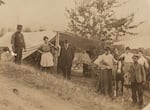
This image circa 1890s shows members of the Flowers family at their Portland area farm.
Courtesy of the Oregon Historical Society, OrgLot 865
Oregon Historical Society Digital Collections
The images are part of the Oregon Historical Society’s Digital Collections website. Digital Collections Manager Mathieu Deschaine said via email, “The Collections launched in 2017 as a platform to share items from our research library collections.”
Since then, OHS has added nearly 40,000 items, including manuscripts, photographs, films, maps and oral histories, with new content added almost weekly.
“We try to provide a diverse spectrum of content in both type and topics,” Deschaine said.
Rare images show early Black residents
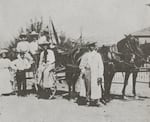
This image circa 1910 shows the Flowers family with a horse-drawn wagon.
Courtesy of the Oregon Historical Society, OrgLot 865
This particular batch of photographs offers a rare glimpse into the lives of Oregon’s earliest Black residents.
The 1860 census only lists 128 Black residents in Oregon out of a population of over 52,000.
At the time, racist exclusion laws banned Black people from living in the state, but some settled here anyway — including Allen Flowers.
Allen Flowers arrives in Portland
Flowers was born in Ohio in 1847, and his family traveled to California during the Gold Rush.
As a young man, he worked as a cabin boy on the Brother Jonathan Steamship. When it arrived in Portland in 1865, he jumped ship. That probably saved his life.
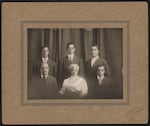
This 1920s-era formal portrait of the Flowers family shows left to right, bottom row - Allen Flowers (father), Lousia Flowers (mother), Floyd Flowers (son). Top row - Ralph Flowers (son), Elmer Flowers (son), Ervin Flowers (son) .
Courtesy of Oregon Historical Society OrgLot 865
Later that year, the Brother Jonathan sank near Crescent City in what was the West Coast’s deadliest passenger wreck of the time, killing over 200 people.
In 1934, the Oregonian reported in Flowers’ obituary that for several years, he “worked on the boats plying rivers to The Dalles, Umatilla and Lewiston.”
Flowers family operates several businesses, spanning decades
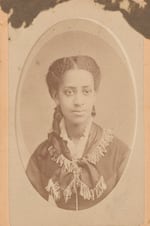
This portrait shows Louisa M. Thacker circa 1872.
Courtesy of the Oregon Historical Society, Org Lot 865_F2_007
Allen Flowers married Louisa Matilda Thacker in British Columbia in 1862. Lousia Thacker (spelled Thatcher in some sources) was born in Boston, Massachusetts, in 1849. Allen and Louisa had four sons who would go on to operate several family businesses in Oregon.
In 1900, the Flowers family bought a 20-acre farm on the slopes of Mount Scott in Southeast Portland, where they grew raspberries and raised horses. The family was also active in several community organizations, including the Bethel African Methodist Episcopal Church, the National Association for the Advancement of Colored People and the Williams Avenue Young Women’s Christian Association.
Images in the collection show the Flowers family farm, the Flowers automotive repair and sales lot, a jitney bus operated by Ralph Flowers and beach cottages in Oceanlake, Oregon.
The entire Flowers photograph collection consists of 27 images dating from around the 1860s to 1955.
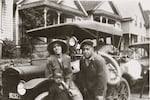
This image circa 1920-1925 shows Ruth Flowers, Ralph Flowers and Clifford Flowers with an automobile.
Courtesy of the Oregon Historical Society, Org Lot 865_F3_007
Roscoe Dixon settles in Astoria
The other recently digitized collection consists of six images of the Dixon family from 1870 to 1945. They lived in Astoria and Seattle.
Roscoe Dixon was born into slavery in Virginia in 1843, eventually escaping through the Underground Railroad.
In the 1880s, he opened Roscoe’s First Class Oyster Saloon in Astoria. Advertisements in the Morning Astorian from 1883 describe it as a “first class Oyster Saloon for Ladies and Gents.”
The group Oregon Black Pioneers credits Dixon as the first known Black business owner in Astoria.
In 1892, he married Theresa Townes Brown of Georgia. They had three children and eventually moved to Seattle.
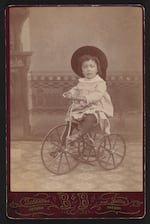
This portrait, circa 1885, shows Chester Dixon as a young child.
Courtesy of the Oregon Historical Society, OrgLot 1421
Learn more about the history of Oregon’s Black Pioneers in this Oregon Experience documentary.
Additional historical treasures to be available soon
According to Deschaine, OHS is on the verge of adding the first uploads of original June Drake images. Drake was a popular photographer from Silverton in the early 1900s. Deschaine said, “I anticipate we’ll be adding new Drake items over the course of the year, but when completed, the project will be around 3,800 negatives.”
Other items in the works include digitizing and translating items from the Yasui Family papers. This year that will include excerpts from Masuo Yasui’s diaries of his experiences immigrating to the United States and establishing his family in Hood River, documentation of the family’s incarceration in WWII and their attempts to rebuild after regaining their freedom.
Deschaine added that they are continually adding more Oral Histories and currently have well over 550 interviews featuring thousands of hours of audio recordings available online.

“Oregon Experience” behind the scenes: Solving a mystery?
When I first saw the new Dixon and Flowers Collection online, I was immediately intrigued by an image of Roscoe Dixon. To my eyes, it looked remarkably similar to another mystery image of an unknown man found among a scrapbook listed as “Notables Photographic Collection, circa 1878” at the Oregon Historical Society library.
The scrapbook contains 523 lithographs, cyanotypes and black and white photographs, including people like early Portland mayor and real estate developer William Ladd, Fort Vancouver’s John McLoughlin and Judge Matthew Deady.
Among the collection are images of two unidentified Black men. With few Black residents in the region in the 1870s, I found the unnamed photos an interesting mystery, and we produced a short video about images.
Could Roscoe Dixon be one of the men from the mystery images?
OHS dates the newly digitized image of Dixon to about 1881. The unnamed image is thought to be from the 1870s.
Unfortunately, neither image is ideal quality for this type of scrutiny, and there do appear to be some differences. Roscoe looks to have a slight widow’s peak, while the unidentified man does not. The noses aren’t quite the same. Or maybe that is due to the different angles of the head. I’m unsure.
I reached out to OHS Photographs Librarian Laura Cray to ask her opinion. She was more skeptical, saying only “it could be” the same person, but more research is necessary. She’s right, of course.
What do you think? Could both of these men be Oregon businessman Roscoe Dixon, taken a decade or so apart?
For now, the mystery continues.
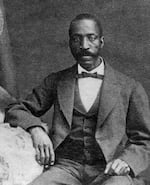
This image of an unidentified man is thought to have been taken in the 1870s in Portland, Oregon. It is among a collection of Oregon Historical Society images listed as only as "Noteables Photographs."
Courtesy of the Oregon Historical Society
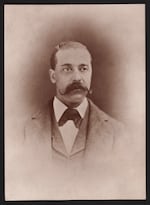
This portrait, circa 1881, shows Astoria businessman Roscoe Dixon.
Courtesy of the Oregon Historical Society, OrgLot1421_004
